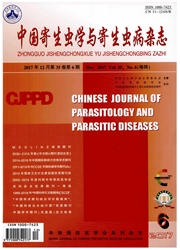

 中文摘要:
中文摘要:
目的分析和比较我国湖区和山区以县为单位的人群血吸虫感染血清学阳性率时空分布格局。方法采用贝叶斯时空模型,对2002—2005年全国以县为单位的血吸虫病年报资料中血清学检查数据、中分辨率成像光谱辐射计(MODIS)数据、归一化植被指数(NDVI)、地表温度(LsT)和土地覆盖类型以及经济水平指标进行分析。结果在湖区,人群血吸虫血清学阳性率与7~8月NDVI均值、水体比例和草地等比例呈正相关(回归系数分别为0.650、0.662和0.832);在山区,人群血吸虫血清学阳性率与1~2月NDVI均值和草地等比例呈正相关(回归系数分别为2.631和0.400),与7~8月NDVI均值呈负相关(回归系数为-0.288)。湖区人群血吸虫血清学阳性率每年空间相关系数位于0.868~0.945之间,山区的多数年份无统计学意义。结论在湖区和山区,自然环境因素对血吸虫病的影响有所不同;湖区人群血吸虫血清学阳性率存在很强的空间相关性且每年略有差异,而山区的空间相关性不强。
 英文摘要:
英文摘要:
Objective To analyze and compare the spatio-temporal structure and risk factors of county-level seroprevalence of Schistosoma japonicum infection in lake and mountainous regions. Methods Bayesian spatio-temporal models were used to analyze the county-level data from serological tests, which was part of the annual reports on S. japonicum infection in China from 2002 to 2005; also used were normalized difference vegetation index (NDVI), land surface temperature (LST), land use type from Moderate Resolution Imaging Spectroradiometer (MODIS), and the index of economic level. Results The seroprevalence was positively associated with the mean of LST from July to August, the proportion of water body and that of grassland in lake region (regression coefficient: 0.650, 0.662 and 0.832, respectively), while in mountainous region, the seroprevalence was positively associated with the mean of LST from January to February and the proportion of grassland (regression coefficient: 2.631 and 0.400, respectively), and negatively associated with the mean of LST from July to August (regression coefficient: -0.288). The spatial correlation coefficients ranged from 0.868 to 0.945 for lake region while they were not significant for most years in mountainous region. Conclusion The impact of environmental factors on seroprevalence of S. japonicum infection varies in different regions. Seroprevalence presents a strong spatial correlation in lake region with certain yearly variability, but such spatial correlation is weak in mountainous region.
 同期刊论文项目
同期刊论文项目
 同项目期刊论文
同项目期刊论文
 Effect of floods on the transmission of schistosomiasis in the Yangtze River valley, People's Republ
Effect of floods on the transmission of schistosomiasis in the Yangtze River valley, People's Republ Spatial epidemiology in zoonotic parasitic diseases: insights gained at the 1(st) International Symp
Spatial epidemiology in zoonotic parasitic diseases: insights gained at the 1(st) International Symp The effect of temperature on the development of Angiostrongylus cantonensis (Chen 1935) in Pomacea c
The effect of temperature on the development of Angiostrongylus cantonensis (Chen 1935) in Pomacea c Three Gorges Dam and its impact on the potential transmission of schistosomiasis in regions along th
Three Gorges Dam and its impact on the potential transmission of schistosomiasis in regions along th Bayesian Spatio-Temporal Modeling of Schistosoma japonicum Prevalence Data in the Absence of a Diagn
Bayesian Spatio-Temporal Modeling of Schistosoma japonicum Prevalence Data in the Absence of a Diagn An integrated approach to identify distribution of Oncomelania hupensis, the intermediate host of Sc
An integrated approach to identify distribution of Oncomelania hupensis, the intermediate host of Sc Tribendimidine and Albendazole for Treating Soil-Transmitted Helminths, Strongyloides stercoralis an
Tribendimidine and Albendazole for Treating Soil-Transmitted Helminths, Strongyloides stercoralis an Landscape genetics: the correlation of spatial and genetic distances of Oncomelania hupensis, the in
Landscape genetics: the correlation of spatial and genetic distances of Oncomelania hupensis, the in China's new strategy to block Schistosoma japonicum transmission: experiences and impact beyond schi
China's new strategy to block Schistosoma japonicum transmission: experiences and impact beyond schi 期刊信息
期刊信息
